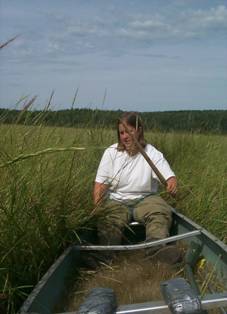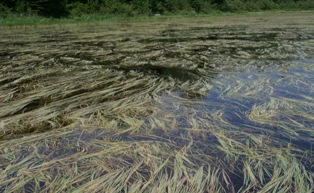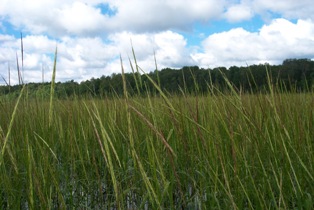Traditional wild rice harvesting and finishing includes knocking, drying, parching, hulling, and winnowing.
 Wild rice harvesting usually begins in late August in northeastern Minnesota. Two people in a canoe typically cooperate to harvest wild rice. One person guides the canoe using a push pole, while the other uses knockers (or flails) to harvest the rice. With a knocker in each hand, the ricer reaches to one side and pulls the stalks over the canoe. Care is taken not to break or damage the plants. The other knocker is then used to gently knock or brush the stalks to remove the rice kernels into the canoe. Ripe wild rice will easily fall from the stalks by using a light brushing stroke.
Wild rice harvesting usually begins in late August in northeastern Minnesota. Two people in a canoe typically cooperate to harvest wild rice. One person guides the canoe using a push pole, while the other uses knockers (or flails) to harvest the rice. With a knocker in each hand, the ricer reaches to one side and pulls the stalks over the canoe. Care is taken not to break or damage the plants. The other knocker is then used to gently knock or brush the stalks to remove the rice kernels into the canoe. Ripe wild rice will easily fall from the stalks by using a light brushing stroke.
After harvesting, wild rice is soon dried by spreading it out in a layer on a tarp, canvas, or blanket. The rice is frequently stirred to dry it evenly. The rice is also cleaned during this time by removing leaves, weeds, dirt, etc.
Dried wild rice is then parched or roasted by placing it in an iron kettle or washtub over a slow burning wood fire. The rice must be stirred constantly with a paddle to prevent it from burning.
After parching has been completed, the wild rice is hulled to remove the chaff from the kernel. A small pit is dug into the ground and lined with wood or other material. The rice is placed in the pit and is danced or treaded upon in a circular motion. Dancers use poles for balance and to control how much pressure is put on the rice.
Finally, the chaff is removed by winnowing (or called fanning). The rice is placed in a winnowing tray and tossed into the air or allowed to fall to the ground. The chaff is blown away by the wind. Wild rice is ready for storage or cooking once the chaff is removed.
"WILD" RICE VS "PADDY" RICE
Paddy grown wild rice is commonly found for sale in stores and roadside stands. Paddy rice is cultivated in artificially created fields and is mechanically harvested. It can be hybridized and grown with fertilizers, herbicides, and insecticides.
How can you tell the difference between paddy grown and naturally grown wild rice?
The cooking time, color, smell, taste, and packaging are all signs. Paddy rice is darker in color (usually black) and requires a longer cooking time (1-2 hours). Natural wild rice, on the other hand, is typically light brown in color and is ready to eat after 15-30 minutes of cooking. Paddy rice requires labeling under Minnesota and Wisconsin law stating that it was commercially produced. Although paddy rice is sold at a lower price, natural wild rice is thought to be a superior product that contains a rich nutty flavor.
 Several varieties of wild rice have been identified. Although some confusion exists with taxonomic classification, the wild rice found in northeastern Minnesota can be classified as Zizania palustris (however it is often classified as Zizania aquatica).
Several varieties of wild rice have been identified. Although some confusion exists with taxonomic classification, the wild rice found in northeastern Minnesota can be classified as Zizania palustris (however it is often classified as Zizania aquatica).




